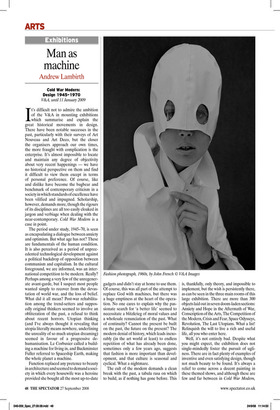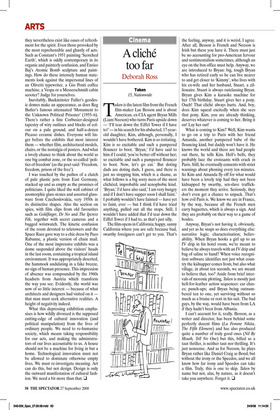Man as machine
Andrew Lambirth
Cold War Modern: Design 1945–1970 V&A, until 11 January 2009
It’s difficult not to admire the ambition of the V&A in mounting exhibitions which summarise and explain the great historical movements in design. There have been notable successes in the past, particularly with their surveys of Art Nouveau and Art Deco, but the closer the organisers approach our own times, the more fraught with complication is the enterprise. It’s almost impossible to locate and maintain any degree of objectivity about very recent happenings — we have no historical perspective on them and find it difficult to view them except in terms of personal preference. Of course, like and dislike have become the bugbear and benchmark of contemporary criticism in a society in which standards of excellence have been vilified and impugned. Scholarship, however, demands more, though the rigours of its disciplines are all too easily cloaked in jargon and verbiage when dealing with the near-contemporary. Cold War Modern is a case in point.
The period under study, 1945–70, is seen as encapsulating a dialogue between anxiety and optimism. But what age has not? These are fundamentals of the human condition. It is also perceived as a period of unprecedented technological development against a political backdrop of opposition between communism and capitalism. In the cultural foreground, we are informed, was an international competition to be modern. Really? Perhaps among a very few of the unregenerate avant-garde, but I suspect most people wanted simply to recover from the devastation of world war, and the loss of belief. What did it all mean? Post-war rehabilitation among the trend-setters and supposedly original thinkers seemed to involve an obliteration of the past, a refusal to think about recent horrors. Utopian thinking (and I’ve always thought it revealing that utopia literally means nowhere, underlining the unreality of so much utopian dreaming) seemed in favour of a progressive dehumanisation. Le Corbusier called a building a machine for living in, and Buckminster Fuller referred to Spaceship Earth, making the whole planet a machine.
Function replaced any pretence to beauty in architecture and seemed to demand a society in which every housewife was a heroine provided she bought all the most up-to-date gadgets and didn’t stay at home to use them. Of course, this was all part of the attempt to replace God with machines, but there was a huge emptiness at the heart of the operation. No one cares to explain why the passionate search for ‘a better life’ seemed to necessitate a blitzkrieg of moral values and a wholesale renunciation of the past. What of continuity? Cannot the present be built on the past, the future on the present? The modern denial of history, which leads inexorably (in the art world at least) to endless repetition of what has already been done, sometimes only a few years ago, suggests that fashion is more important than development, and that culture is seasonal and cyclical. What a nightmare.
The cult of the modern demands a clean break with the past, a tabula rasa on which to build, as if nothing has gone before. This is, thankfully, only theory, and impossible to implement, but the wish is persistently there, as can be seen in the three main rooms of this large exhibition. There are more than 300 objects laid out in seven doom-laden sections: Anxiety and Hope in the Aftermath of War, Conscription of the Arts, The Competition of the Modern, Crisis and Fear, Space Odysseys, Revolution, The Last Utopians. What a list! Relinquish the will to live a rich and useful life, all you who enter here.
Well, it’s not entirely bad. Despite what you might expect, the exhibition does not single-mindedly foster the pursuit of ugliness. There are in fact plenty of examples of inventive and even satisfying design, though not much beauty to be found. It’s always a relief to come across a decent painting in these themed shows, and although these are few and far between in Cold War Modern, they nevertheless exist like oases of refreshment for the spirit. Even those provoked by the most reprehensible and ghastly of acts. Such as Constant’s 1951 painting ‘Scorched Earth’, which is oddly contemporary in its organic and painterly confusion, and Enrico Baj’s Atomic Bomb sculpture and paintings. How do these intensely human statements look against the impersonal lines of an Olivetti typewriter, a Gio Ponti coffee machine, a Vespa or a Messerschmidt cabin scooter? Judge for yourselves.
Inevitably, Buckminster Fuller’s geodesic domes make an appearance, as does Reg Butler’s famous attenuated ‘Monument to the Unknown Political Prisoner’ (1955–6). There’s rather a fine Corbusier-designed tapestry of wiry outlines and blocks of colour on a pale ground, and half-a-dozen Picasso ceramic dishes. Everyone will linger before the exhibits that most interest them — whether film, architectural models, chairs, or the nostalgia of posters. And what a lovely chance to think about the world as one big combat zone, or the so-called ‘politics of freedom’ (as the poet said: ‘Freedom, freedom, prison of the free’).
I was touched by the pathos of a clutch of pale plastic pots from East Germany, stacked up and as empty as the promises of politicians. I quite liked the wall cabinet of zoomorphic glass stones and assorted glassware from Czechoslovakia, very 1950s in its distinctive shapes. Also the section on spies, with film clips from old favourites such as Goldfinger, Dr No and The Ipcress File, together with secret cameras and a bugged wristwatch. The kinetic confusion of the room devoted to teletowers and the Space Race gave way to a chic dress by Paco Rabanne, a plastic version of chain mail. One of the most impressive exhibits was a dome suspended above the visitors’ heads in the last room, containing a tropical island environment. It was appropriately deserted, the hammock undulating in a fake breeze, no sign of human presence. This impression of absence was compounded by the 1960s headsets from Austria which transform the way you see. Evidently, the world was now of so little interest — because of what architects and designers had visited on it — that man must seek alternative realities. A height of negativity indeed.
What this depressing exhibition emphasises is how wildly divorced is the supposed cutting-edge of cultural innovation (and political manipulation) from the lives of ordinary people. We need to re-humanise society, which means taking responsibility for our acts, and making the administrators of our lives accountable to us. A house should not be a machine for living in but a home. Technological innovation must not be allowed to dominate otherwise empty lives. We must re-investigate meaning. Art can do this, but not design. Design is only the outward manifestation of cultural fashion. We need a bit more than that. ❑











































































 Previous page
Previous page